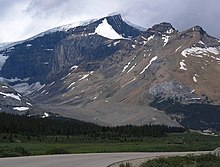Contents
Mount Kitchener is a mountain located within the Columbia Icefield of Jasper National Park, which is part of the Canadian Rockies. The mountain can be seen from the Icefields Parkway (highway 93) near Sunwapta Pass.
Mt. Kitchener was originally named Mount Douglas by J. Norman Collie after David Douglas. In 1916, the mountain was renamed Mount Kitchener, its present-day name, after Lord Kitchener, who had just been killed in World War I.[1]
Climbing
- Routes
- SouthWest Slopes (Normal Route) I
- Grand Central Couloir V 5.9
- Ramp Route V 5.8
- Notable ascents
- 1975 Grand Central Couloir (V 5.9 WI5 1050m) by Jeff Lowe and Michael Weis (August 1975)[5]
Mount K2

Mount K2, elevation 3,090m,[2] was named in 1938 by Rex Gibson (former Alpine Club of Canada president), apparently to signify this as a secondary peak of Mount Kitchener.[6]
Climate
Based on the Köppen climate classification, Mount Kitchener is located in a subarctic climate zone with cold, snowy winters, and mild summers.[7] Temperatures can drop below −20 °C (−4 °F) with wind chill factors below −30 °C (−22 °F).
References
- ^ a b c "Mount Kitchener". cdnrockiesdatabases.ca. Retrieved 2007-08-31.
- ^ a b "Topographic map of Mount Kitchener". opentopomap.org. Retrieved 2021-03-31.
- ^ "Mount Kitchener". Bivouac.com. Retrieved 2013-05-17.
- ^ a b "Mount Kitchener". Geographical Names Data Base. Natural Resources Canada. Retrieved 2021-03-31.
- ^ Lowe, Jeff (1976). "Winter Ice Climbing and its Techniques on Kitchener". The Cold Dance Review. American Alpine Journal. 20 (50). New York, NY, USA: American Alpine Club: 326–333. Retrieved 2021-03-31.
- ^ "Mount K2". cdnrockiesdatabases.ca. Retrieved 2020-11-21.
- ^ Peel, M. C.; Finlayson, B. L.; McMahon, T. A. (2007). "Updated world map of the Köppen−Geiger climate classification". Hydrol. Earth Syst. Sci. 11: 1633–1644. ISSN 1027-5606.
External links
 Media related to Mount Kitchener at Wikimedia Commons
Media related to Mount Kitchener at Wikimedia Commons- Parks Canada web site: Jasper National Park
- "Mount Kitchener". Peakware.com. Archived from the original on 2016-03-04.
Gallery
-
View from Mt. Kitchener's summit
-
Mount Kitchener's north face
-
Mt Kitchener Summit from Snow Dome
-
View to N. from Mt. Kitchener





